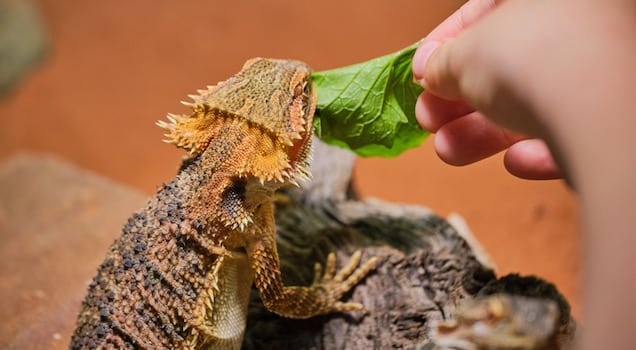
Are Dubia Roaches Good for Bearded Dragons?
Bearded dragons are omnivores and should eat a varied diet consisting of both plants and insects. Aside from fresh fruits and veggies, feeder insects should form a large part of their diet. These reptiles will happily eat most types of insects, but if there’s one thing for certain, it’s that they specifically love dubia roaches.
This is great because dubia roaches are a highly recommended protein source for various reasons. They are easy to digest, taste delicious, and provide the right balance of nutrients compared to other feeder insects.
If you are interested in feeding dubia roaches to your bearded dragon, this article will tell you every you need to know.
Overview of Dubia Roaches
Dubia roaches are medium-sized roaches and popular feeder insects for many types of reptiles and amphibians. They are native to parts of Central and South America and can be found roaming forest floors where they feed off decaying plants.
It can be challenging to distinguish them from other roaches, but they stand out with their short antennas, lack of wings, and average size of 1.6 to 1.8 inches. Their coloration varies depending on factors like age and genetics, but most adults are dark brown.
These adaptable creatures tolerate various conditions but thrive in warm, humid environments. Their adaptability also makes them easy to maintain as feeders. Also, they are prolific breeders and mature within 4 to 6 months, making them an ideal constant protein source for bearded dragons.
Female dubia roaches incubate eggs for about 28 days, and the nymphs (baby dubia roaches) hatch entirely white. It can take up to seven molts before dubia roaches become fully grown, and they are safe for bearded dragons to eat at any life stage.
Nutritional Benefits of Dubia Roaches
Nutritional content of dubia roaches:
- Protein: 22 – 36%
- Fat: 6 – 8%
- Fiber: 3 – 8%
- Moisture: 65%
- Calcium: 700 – 800 mg/kg
- Phosphorus: 2600 mg/kg
Dubia roaches are a nutritious protein source for hatchling, juvenile, and adult bearded dragons alike. Protein comprises essential amino acids that support proper growth and development and important bodily functions like muscle growth and hormone synthesis.
Dubia roaches are lower in fat and chitin than other popular feeders like crickets and superworms. Chitin refers to the roach’s exoskeleton and is difficult for bearded dragons to digest in large quantities. This makes dubia roaches one of the more digestible, protein-rich, and nutritious feeders for reptiles. Their low-fat content makes them a healthy staple feeder for most reptiles and is less likely to cause excessive weight gain.
Furthermore, dubia roaches have a decent calcium-to-phosphorus ratio of about 4:1 to 3:1. Although the ideal ratio for bearded dragons is 2:1, they still have a better calcium ratio than most feeder insects. Calcium is necessary for bone health and to prevent health issues related to calcium deficiencies, such as metabolic bone disease.
Feeding Dubia Roaches to Bearded Dragons
Bearded dragons can eat dubia roaches at any growth stage, and these roaches are nutritious enough to be fed frequently.
Hatchlings (0 – 4 Months)
Hatchling bearded dragons can eat between 15 to 25 small dubia roaches per day. They eat more insects at this age because they grow rapidly and rely on a high-protein diet to support their growth. However, you don’t want to feed too many at once, so reduce feedings to two to three times a day. Make sure the dubia roaches are smaller than the space between their eyes to prevent choking, ideally in the nymph stage.
Juveniles (4 – 12 Months)
Juvenile bearded dragons can eat between 10 to 15 dubia roaches up to twice daily. They still require a high-protein diet for growth but are no longer in the rapid growth phase and don’t need to eat as much as hatchlings. You should only feed small to medium-sized roaches about ½ an inch in size.
Adults (12+ Months)
An adult bearded dragon can eat 3 to 5 adult dubia roaches daily or a few times a week. They need less protein than growing bearded dragons and should only eat every 24 to 72 hours. However, they need more vegetables and fruit at this stage.
Gut Loading and Nutrient Boosting
Dubia roaches are already nutritious on their own, but they should still be gut-loaded to increase their nutritional value. Gut-loading insects also encourage growth and breeding and maximize their lifespan so that they can become a constant food source for your bearded dragon. However, this process is done to benefit the reptile that eats them rather than for the health of the feeder.
An ideal gut-loading diet should be low in protein, fortified with vitamins and minerals, and free from artificial colors and flavors. Commercial insect diets are preferred over fresh fruits and veggies because they offer superior nutrition. Look for one that has less than 20% protein and is formulated with ingredients like flowers, fruit, and alfalfa. It should also have a calcium-to-phosphorus ratio of at least 1:1 to 2:1.
As with any feeder, dubia roaches should be gut loaded at least 6 hours before being fed to bearded dragons, with 24 hours being ideal.
Handling and Preparation of Dubia Roaches
It’s important to handle and prepare dubia roaches correctly for both you and your bearded dragon’s safety.
You should always wear gloves when handling dubia roaches or touching items in their enclosure. Not only are their living conditions unhygienic because it’s contaminated with poop and bacteria, but some people can be allergic to them as well.
It’s a good idea to use reptile tongs when feeding them to your bearded dragon rather than using your hands or a container. Dubia roaches can easily escape our hands or open containers and are very difficult to catch afterward.
They should also be dusted with a calcium and vitamin D3 supplement to increase their nutritional content during each feeding. Hatchling and juvenile bearded dragons should have their feeder insects dusted with supplements daily to support their rapid growth phase.
Benefits of Feeding Dubia Roaches to Bearded Dragons
Here are four benefits of feeding dubia roaches to bearded dragons:
Low-Maintenance
One of the many reasons reptile’ hobbyists prefer dubia roaches over other feeder insects is that they are low-maintenance and easy to care for. They tend to be less messy than crickets or locusts. Plus, they are versatile and can thrive in different living conditions.
Odorless and Silent
Unlike other popular feeders like crickets, dubia roaches are relatively odorless. They do not produce the same smelly pheromones as crickets, making them less likely to smell up your home. Furthermore, they do not make much noise unless they are eating or chewing.
Low in Chitin
Many feeder insects contain approximately 10% chitin because of their thick exoskeletons. However, dubia roaches contain between 3 – 5% chitin, making them highly digestible for most reptiles. Bearded dragons cannot digest large quantities of chitin, leading to issues with digestion and impaction.
Excellent Protein Source for Growing Bearded Dragons
Lastly, dubia roaches are incredibly high in essential proteins and amino acids that young bearded dragons need for growth. Hatchling and juvenile bearded dragons are primarily insectivores, so about 80% of their diet should contain protein-rich insects.
Potential Risks and Considerations
There are numerous benefits to feeding dubia roaches to bearded dragons, but still a few potential risks to consider.
Remember that only commercial dubia roaches are safe as feeders and shouldn’t be wild-caught. This is because wild-caught insects can harbor dangerous diseases and parasites that can be transferred to the reptile that eats them. Also, bearded dragons must only eat live dubia roaches. Dead roaches can carry bacteria and parasites that could make your reptile sick.
As with any feeder insects, dubia roaches must be raised in clean, well-maintained conditions. Their enclosure should be regularly cleaned, and their living conditions should replicate their wild habitat. You don’t want to feed insects that are soiled with poop, dirty substrate, or old food to your bearded dragon.
There is also the risk that your bearded dragon could be allergic to dubia roaches, which can lead to digestive – and skin issues. They might not necessarily be allergic to the insect, but to their waste products or the substrate, they are raised with. If your bearded dragon is showing signs of lethargy, inflamed skin, or respiratory issues, there is a possibility that they could be allergic to their food and should be checked out by an exotic veterinarian.
Alternatives to Dubia Roaches for Bearded Dragons
Here are the three best feeder insect alternatives to dubia roaches:
Crickets
- Protein: 21%
- Fat: 6%
- Fiber: 12%
- Calcium-to-phosphorus ratio: 13:1
| Pros: | Cons: |
| High in protein and essential amino acids. | Produce more of an unpleasant smell and mess than feeder worms and dubia roaches. |
| Higher fiber content than dubia roaches. | Make noisy chirping sounds during the night. |
| High in chitin, which is difficult to digest in large amounts. | Imbalanced calcium-to-phosphorus ratio. |
| Inexpensive and widely available at most pet stores. | High in chitin which is difficult to digest in large amounts. |
Mealworms
- Protein: 20%
- Fat: 13%
- Fiber: 2%
- Calcium-to-phosphorus ratio: 1:5
| Pros: | Cons: |
| High in protein, calcium, phosphorus, and vitamin A. | Contains significantly more phosphorus than calcium. |
| Easy to maintain as a constant food source. | They are difficult to digest because they are low in fiber and high in chitin. |
| Have a high moisture content of about 60%, which helps keep reptiles hydrated. | Difficult to digest because they are in low fiber and high in chitin. |
Discoid Roaches
- Protein: 20 – 30%
- Fat: 7%
- Fiber: 3%
- Calcium-to-phosphorus ratio: 1:3
| Pros: | Cons: |
| Good alternative for bearded dragons or people with allergies to dubia roaches. | Have more chitin than dubia roaches. |
| Low-maintenance and easy to raise as feeders. | High in phosphorus. |
| Legal Florida alternative. | Skilled escape artists and faster than other roaches. |
FAQs About Using Dubia Roaches for Bearded Dragons
Can I feed wild-caught dubia roaches to my bearded dragon?
No, bearded dragons should only eat commercial feeder dubia roaches purchased from a pet store. Wild-caught dubia roaches can potentially make reptiles sick because they are contaminated with diseases, parasites, and sometimes pesticides or harsh chemicals from their environment.
Are dubia roaches illegal in some states?
Yes, dubia roaches are illegal in Florida, Canada, and Hawaii because they are considered invasive. This means that you cannot import them or keep them as feeders in these states.
How many dubia roaches to feed bearded dragons?
- Hatchlings (0 – 4 Months): 15 to 25 dubia roaches in the nymph stage.
- Juveniles (4 – 12 Months): 10 to 15 small to medium-sized dubia roaches.
- Adults (12+ Months): 3 to 5 medium to adult-sized dubia roaches.
Conclusion
Bearded dragons are omnivores that can benefit from eating dubia roaches as a high-protein, low-fat, highly digestible meal. Dubia roaches are a popular feeder for most reptiles because they are nutritious, easy to maintain, and readily available from most pet stores. They are safe for bearded dragons of all life stages but must be fed alongside a balanced, varied diet consisting of fresh fruit and veggies and vitamin D3 and calcium supplements.



